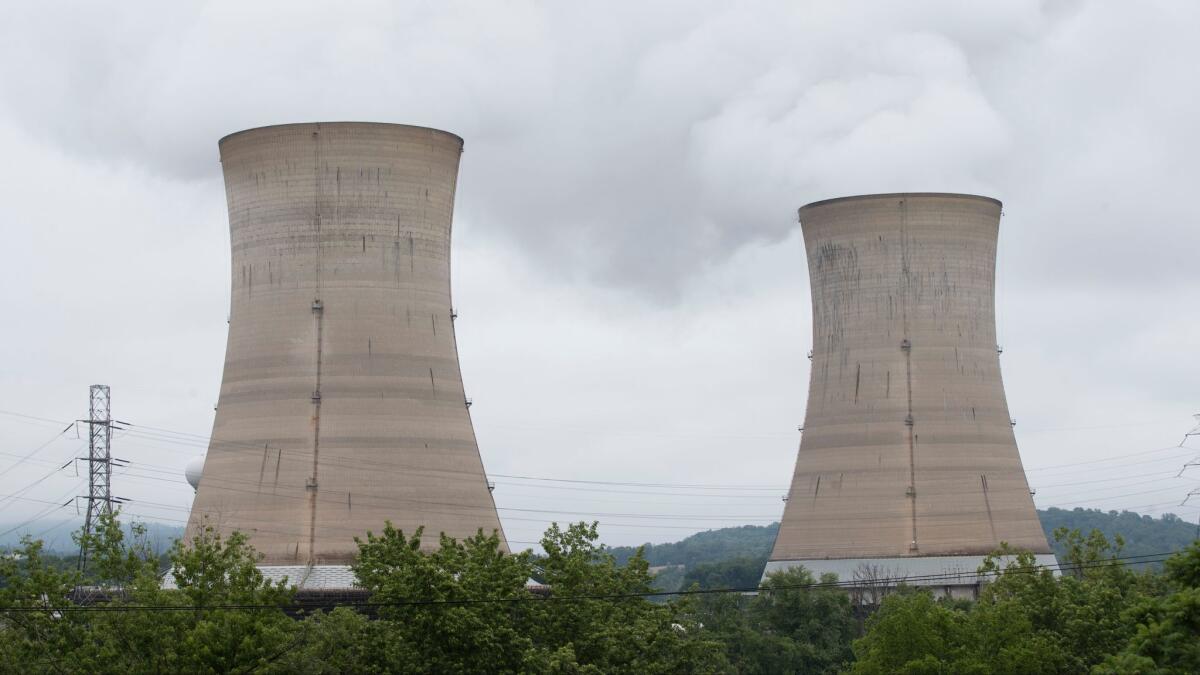Column: In another sign of the end of nuclear power, shutdown looms for Three Mile Island

- Share via
Three Mile Island, the nuclear power plant located about 10 miles from Harrisburg, Pa., has stood as a symbol of nuclear incompetence for 38 years, or since the reactor in its Unit 2 partially melted down on March 28, 1979.
Today it’s about to become a symbol of another feature of America’s nuclear power industry: the impossibility of turning a profit. The owner of the plant’s undamaged Unit 1, the nuke-heavy energy company Exelon, announced Tuesday that it will permanently shut down the unit in September 2019. Exelon said a week ago that the plant hasn’t been profitable in five years. The company will take a charge of as much as $110 million this year related to the operation and planned shutdown.
It’s unclear whether Exelon actually intends to close Three Mile Island, or if its announcement is designed as something of a threat to force the state of Pennsylvania to deliver an operating subsidy. In announcing the shutdown, Exelon groused that nuclear power hasn’t received favorable treatment as a renewable energy source in the state’s energy policy as have solar, wind and hydro power.
As alarms rang and warning lights flashed, the operators ... took a series of actions that made conditions worse.
— Nuclear Regulatory Commission, recounting the 1979 Three Mile Island accident
Exelon warned that “absent policy reforms, the loss of Pennsylvania nuclear plants would increase air pollution, compromise the resiliency of the electric grid, raise energy prices for consumers, eliminate thousands of good-paying local jobs and weaken the state’s economy.” The announcement leaned heavily on the economic impact of the shutdown, which Exelon says will mean layoffs for as many as 675 workers directly employed at the site as well as the loss of “more than $1 million in state property taxes and more than $300,000 in local community giving each year.” Three Mile Island is licensed by the Nuclear Regulatory Commission to operate through 2034, so the shutdown would come 15 years early.
Still, the company had to acknowledge that nuclear power just isn’t competitive with other renewables or with natural gas generating plants. Three Mile Island was unable to sell its output into the regional electric grid in recent power auctions. “TMI remains economically challenged as a result of continued low wholesale power prices and the lack of federal or Pennsylvania energy policies that value zero-emissions nuclear energy,” Exelon says.
That underscores a chronic malady of American nukes — they’re too hard to operate and simply not competitive. It’s that mismatch of cost that helps account for recent shutdown decisions such as the pending closure in California of Pacific Gas & Electric’s Diablo Canyon nuclear plant and the 2013 abandonment of San Onofre by Southern California Edison after a botched upgrade.
Nor does the economic tide seem about to turn. Just last week, an executive at Sempra Energy, the parent of Southern California Gas and San Diego Gas & Electric Co., and a minority owner of San Onofre, told a utility conference that the technology exists today for California to get all of its power from solar and wind, rather than keeping fossil-fueled generation around to provide constant base-load electricity. “Installing a base-load power plant is no longer your only option,” said Patrick Lee, a Sempra vice president. “You can now look at solar, wind and storage as alternatives, and still be able to manage the reliability of the grid.”
Three Mile Island will always be famous not as an example of nuclear energy’s economic obsolescence, but of the nuclear industry’s slipshod management practices. Starting at 4 a.m. that day in March 1979, multiple failures occurred to produce what still stands as the nation’s worst commercial nuclear accident. A thorough chronology by the NRC can be found here.
The mishap began with a pump failure that blocked cooling water from reaching the reactor core. The reactor immediately shut down. A valve opened to relieve pressure building up conditions in the nuclear unit, but then stuck open instead of closing, allowing cooling water to cascade out of the reactor unit. Plant staff got an erroneous reading indicating the valve had closed, and other information systems provided them with more incorrect or inadequate data.
“As alarms rang and warning lights flashed,” the NRC recounted, “the operators did not realize that the plant was experiencing a loss-of-coolant accident. They took a series of actions that made conditions worse.”
In the end, the nuclear fuel overheated; about half the core melted down. The NRC correctly describes a loss-of-coolant incident as “the most dangerous kind of nuclear power accident,” but asserts that effects outside the plant itself, including radiation releases and health effects in the surrounding area, were minimal.
That said, the affected Three Mile Island Unit 2 was permanently disabled. Its fuel and radioactive waste have been shipped away, and what’s left of the unit is monitored by Exelon.
Keep up to date with Michael Hiltzik. Follow @hiltzikm on Twitter, see his Facebook page, or email michael.hiltzik@latimes.com.
Return to Michael Hiltzik’s blog.
More to Read
Sign up for Essential California
The most important California stories and recommendations in your inbox every morning.
You may occasionally receive promotional content from the Los Angeles Times.














